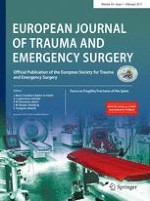Erschienen in:

19.03.2016 | Original Article
Trauma team utilization of universal precautions: if you see something, say something
verfasst von:
T. Peponis, M. C. Cropano, A. Larentzakis, M. G. van der Wilden, Y. A. Mejaddam, C. A. Sideris, M. Michailidou, K. Fikry, A. Bramos, S. Janjua, Y. Chang, D. R. King
Erschienen in:
European Journal of Trauma and Emergency Surgery
|
Ausgabe 1/2017
Einloggen, um Zugang zu erhalten
Abstract
Purpose
The risks deriving from the lack of compliance with universal safety precautions (USPs) are unequivocal. However, the adoption of these prophylactic precautions by healthcare providers remains unacceptably low. We hypothesized that trauma teams are not routinely adhering to USPs and that a brief educational intervention, followed by real-time peer feedback, would substantially improve compliance rates.
Methods
This before-and-after interventional study took place in the resuscitation bay of a Level I Trauma Center during trauma team activations. Six USPs were examined: hand washing (before and after patient contact), use of gloves, gowns, eye protection, and masks. Surgery and Emergency Medicine attending physicians, residents, and nurses, who had direct patient contact, were included. Following 162 baseline observations, an educational intervention in the form of brief lectures was conducted, emphasizing the danger to self from dereliction of USPs. Subsequently, 167 post-intervention observations were made after a one-month period of knowledge decay. Finally, real-time feedback was provided by trauma team leaders and study staff. Adherence to prophylactic measures was recorded again.
Results
Baseline compliance rates were dismal. Only hand washing prior to patient interaction, the use of eye protection, and the use of masks improved significantly (p < 0.05) after the educational initiative. However, compliance rates remained suboptimal. No difference was noted regarding the three other USPs. Impressively, following real-time behavioral corrections, compliance improved to nearly 90 % for all USPs (p < 0.05).
Conclusions
Compliance with OSHA-required USPs during trauma team activations is unacceptably low, but can be dramatically improved through simple educational interventions, combined with real-time peer feedback.